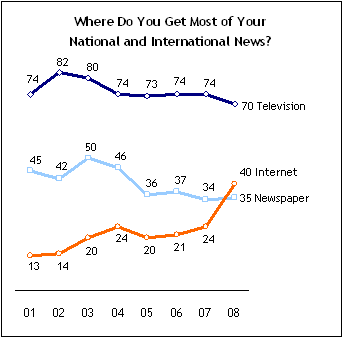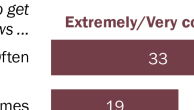Summary of Findings

The internet, which emerged this year as a leading source for campaign news, has now surpassed all other media except television as an outlet for national and international news.
Currently, 40% say they get most of their news about national and international issues from the internet, up from just 24% in September 2007. For the first time in a Pew survey, more people say they rely mostly on the internet for news than cite newspapers (35%). Television continues to be cited most frequently as a main source for national and international news, at 70%.
For young people, however, the internet now rivals television as a main source of national and international news. Nearly six-in-ten Americans younger than 30 (59%) say they get most of their national and international news online; an identical percentage cites television. In September 2007, twice as many young people said they relied mostly on television for news than mentioned the internet (68% vs. 34%).

The percentage of people younger than 30 citing television as a main news source has declined from 68% in September 2007 to 59% currently. This mirrors a trend seen earlier this year in campaign news consumption. (See “Internet Now Major Source of Campaign News,” News Interest Index, Oct. 31, 2008.)
The survey by the Pew Research Center for the People & the Press, conducted Dec. 3-7 among 1,489 adults, finds there has been little change in the individual TV news outlets that people rely on for national and international news. Nearly a quarter of the public (23%) says they get most of their news from CNN, while 17% cite Fox News; smaller shares mention other cable and broadcast outlets.
Top News Stories of 2008

While the 2008 presidential campaign attracted high levels of public attention, the economy was the top story of the year in terms of news interest, according to Pew’s Weekly News Interest Index. In late September, as the nation’s financial crisis deepened, 70% said they were following news about the economy very closely. That ranks among the highest levels of news interest for any story in the past two decades.
News about gas prices, both rising and falling, also attracted considerable public attention. In early June, two-thirds of Americans (66%) said they were tracking news about the rising price of gasoline very closely.
The rising price of gasoline was the top news story in 2007, but far fewer followed news about rising gas prices very closely (52% in May). This year, the falling price of gas also drew broad interest (53% very closely in October).
The congressional debate over legislation to stabilize financial markets also drew extensive interest. In early October, just after President Bush signed the financial rescue measure, 62% followed this story very closely.
Interest in election news remained at historically high levels throughout the lengthy campaign. Interest in the general election peaked in mid-October (at 61%), but approached that level at other points in the campaign. Public interest in the primary campaigns also was higher than during previous primary contests. In mid-February, 44% said they were following news about the candidates for the presidential election very closely.
Notably, the war in Iraq was not among this year’s 15 most closely followed news stories. In mid-July, a third of Americans (33%) said they were following news about the current situation and events in Iraq, the highest percentage measured this year. In 2007, interest in news about the war reached 40% in early January, just before President Bush announced his troop surge; the war in Iraq was the sixth-ranked story last year.
In Pew’s final Weekly News Interest Index for 2008, nearly four-in-ten Americans (37%) say they followed news about the Bush administration’s plan to provide emergency loans to U.S. automakers. That is in line with previous measures of public interest in the debate over whether to aid the struggling automakers. Three-in-ten (30%) paid very close attention to news about a Wall Street investor, Bernard Madoff, who allegedly cheated people out of billions of dollars. Nearly as many (28%) tracked news about an Iraqi journalist throwing his shoes at President Bush very closely, and 25% said they followed news about slumping retail sales during the holiday season very closely.
These findings are based on the most recent installment of the weekly News Interest Index, an ongoing project of the Pew Research Center for the People & the Press. The index, building on the Center’s longstanding research into public attentiveness to major news stories, examines news interest as it relates to the news media’s coverage. The weekly survey is conducted in conjunction with The Project for Excellence in Journalism’s News Coverage Index, which monitors the news reported by major newspaper, television, radio and online news outlets on an ongoing basis. The most recent survey was conducted December 19-22 from a nationally representative sample of 1,013 adults.
About the News Interest Index
The News Interest Index is a weekly survey conducted by the Pew Research Center for the People & the Press aimed at gauging the public’s interest in and reaction to major news events.
This project has been undertaken in conjunction with the Project for Excellence in Journalism’s News Coverage Index, an ongoing content analysis of the news. The News Coverage Index catalogues the news from top news organizations across five major sectors of the media: newspapers, network television, cable television, radio and the internet. Each week (from Sunday through Friday) PEJ compiles this data to identify the top stories for the week. The News Interest Index survey collects data from Friday through Monday to gauge public interest in the most covered stories of the week.
Results for the weekly surveys are based on telephone interviews among a nationwide sample of approximately 1,000 adults, 18 years of age or older, conducted under the direction of ORC (Opinion Research Corporation). For results based on the total sample, one can say with 95% confidence that the error attributable to sampling is plus or minus 3.5 percentage points.
In addition to sampling error, one should bear in mind that question wording and practical difficulties in conducting surveys can introduce error or bias into the findings of opinion polls, and that results based on subgroups will have larger margins of error.
For more information about the Project for Excellence in Journalism’s News Coverage Index, go to www.pewresearch.org/pewresearch-org/journalism.




